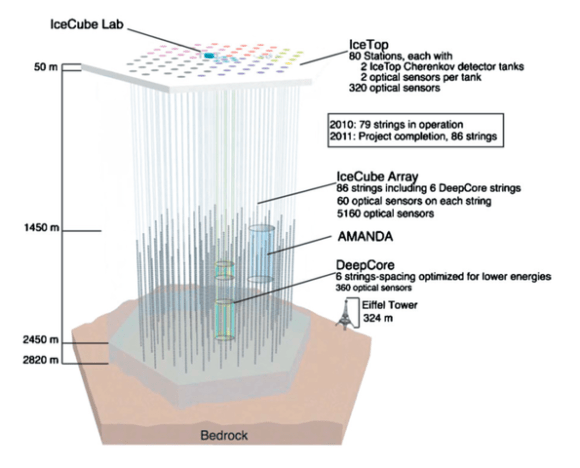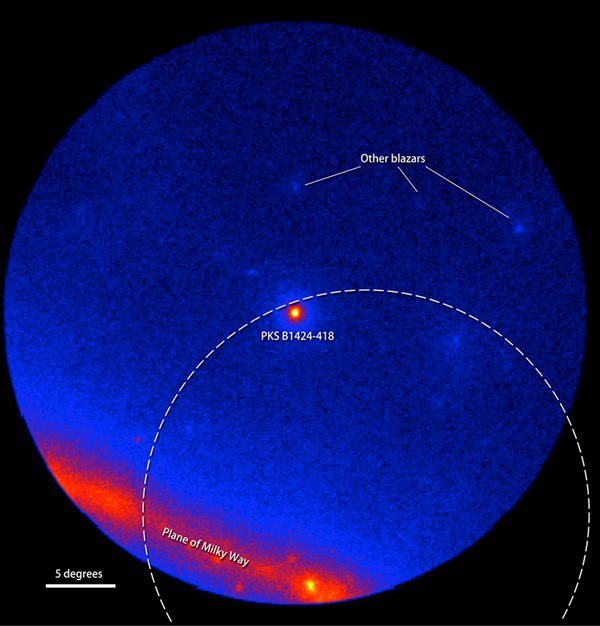A unique observatory buried deep in the clear ice of the South Pole region, an orbiting observatory that monitors gamma rays, a powerful outburst from a black hole 10 billion light years away, and a super-energetic neutrino named Big Bird. These are the cast of characters that populate a paper published in Nature Physics, on Monday April 18th.
The observatory that resides deep in the cold dark of the Antarctic ice has one job: to detect neutrinos. Neutrinos are strange, standoffish particles, sometimes called ‘ghost particles’ because they’re so difficult to detect. They’re like the noble gases of the particle world. Though neutrinos vastly outnumber all other atoms in our Universe, they rarely interact with other particles, and they have no electrical charge. This allows them to pass through normal matter almost unimpeded. To even detect them, you need a dark, undisturbed place, isolated from cosmic rays and background radiation.
This explains why they built an observatory in solid ice. This observatory, called the IceCube Neutrino Observatory, is the ideal place to detect neutrinos. On the rare occasion when a neutrino does interact with the ice surrounding the observatory, a charged particle is created. This particle can be either an electron, muon, or tau. If these charged particles are of sufficiently high energy, then the strings of detectors that make up IceCube can detect it. Once this data is analyzed, the source of the neutrinos can be known.
The next actor in this scenario is NASA’s Fermi Gamma-Ray Space Telescope. Fermi was launched in 2008, with a specific job in mind. Its job is to look at some of the exceptional phenomena in our Universe that generate extraordinarily large amounts of energy, like super-massive black holes, exploding stars, jets of hot gas moving at relativistic speeds, and merging neutron stars. These things generate enormous amounts of gamma-ray energy, the part of the electromagnetic spectrum that Fermi looks at exclusively.
Next comes PKS B1424-418, a distant galaxy with a black hole at its center. About 10 billion years ago, this black hole produced a powerful outburst of energy, called a blazar because it’s pointed at Earth. The light from this outburst started arriving at Earth in 2012. For a year, the blazar in PKS B1424-418 shone 15-30 times brighter in the gamma spectrum than it did before the burst.
Detecting neutrinos is a rare occurrence. So far, IceCube has detected about a hundred of them. For some reason, the most energetic of these neutrinos are named after characters on the popular children’s show called Sesame Street. In December 2012, IceCube detected an exceptionally energetic neutrino, and named it Big Bird. Big Bird had an energy level greater than 2 quadrillion electron volts. That’s an enormous amount of energy shoved into a particle that is thought to have less than one millionth the mass of an electron.

Big Bird was clearly a big deal, and scientists wanted to know its source. IceCube was able to narrow the source down, but not pinpoint it. Its source was determined to be a 32 degree wide patch of the southern sky. Though helpful, that patch is still the size of 64 full Moons. Still, it was intriguing, because in that patch of sky was PKS B1424-418, the source of the blazar energy detected by Fermi. However, there are also other blazars in that section of the sky.
The scientists looking for Big Bird’s source needed more data. They got it from TANAMI, an observing program that used the combined power of several networked terrestrial telescopes to create a virtual telescope 9,650 km(6,000 miles) across. TANAMI is a long-term program monitoring 100 active galaxies that are located in the southern sky. Since TANAMI is watching other active galaxies, and the energetic jets coming from them, it was able to exclude them as the source for Big Bird.
The team behind this new paper, including lead author Matthias Kadler of the University of Wuerzberg in Germany, think they’ve found the source for Big Bird. They say, with only a 5 percent chance of being wrong, that PKS B1424-418 is indeed Big Bird’s source. As they say in their paper, “The outburst of PKS B1424–418 provides an energy output high enough to explain the observed petaelectronvolt event (Big Bird), suggestive of a direct physical association.”
So what does this mean? It means that we can pinpoint the source of a neutrino. And that’s good for science. Neutrinos are notoriously difficult to detect, and they’re not that well understood. The new detection method, involving the Fermi Telescope in conjunction with the TANAMI array, will not only be able to locate the source of super-energetic neutrinos, but now the detection of a neutrino by IceCube will generate a real-time alert when the source of the neutrino can be narrowed down to an area about the size of the full Moon.
This promises to open a whole new window on neutrinos, the plentiful yet elusive ‘ghost particles’ that populate the Universe.


Any mention of what type of neutrino? Can they distinguish between the types and does it matter since they seem to alternate between the three?
Probably not. The type of neutrino can be deduced if you can identify the particles that come out of the initial collision, but to do that you need two things IceCube doesn’t have:
1) A magnetic field to bend particle trajectories to measure their mass, and
2) Closely spaced dectectors so that you can identify the particles before they collide with something else.